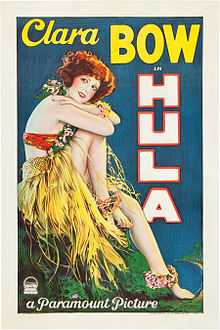Hula (film)
| Hula | |
|---|---|
 | |
| Directed by | Victor Fleming |
| Produced by |
Adolph Zukor Jesse L. Lasky B. P. Schulberg (associate producer) |
| Written by |
Doris Anderson (adaptation) Ethel Doherty (scenario) George Marion, Jr. (titles) Frederica Sagor (uncredited) |
| Based on |
Hula, a Romance of Hawaii by Armine von Tempski |
| Starring |
Clara Bow Clive Brook Arlette Marchal Albert Gran |
| Cinematography | William Marshall |
| Editing by |
E. Lloyd Sheldon Eda Warren |
| Distributed by | Paramount Pictures |
| Release dates |
|
| Running time | 64 minutes |
| Country | United States |
| Language |
Silent English intertitles |
Hula is a 1927 American silent romantic comedy film directed by Victor Fleming, and based on the novel Hula, a Romance of Hawaii by Armine von Tempski. The film stars Clara Bow and was released by Paramount Pictures.[1]
Cast
- Clara Bow as Hula Calhoun
- Clive Brook as Anthony Haldane
- Arlette Marchal as Mrs. Bane
- Albert Gran as Bill Calhoun
- Arnold Kent as Harry Dehan
- Patricia Dupont as Margaret Haldane
- Agostino Borgato as Uncle Edwin
- Duke Kahanamoku as Hawaiian boy
Plot
Hula Calhoun (Clara Bow) is the daughter of a Hawaiian planter, Bill Calhoun (Albert Gran). She follows the advice of her uncle Edwin (Agostino Borgato), and follows a simple and natural life, far from social conventions of her family and is considered a "wild child" who wears pants and rides horses.[2]
Courted with adoration by Harry Dehan (Arnold Kent), Hula prefers a young British engineer, Anthony Haldane (Clive Brook), who came to the island to oversee the construction of a dam on her father's property. However, Haldane is already married. At a party, Haldane tries to keep his distance but Hula gets drunk and performs a seductive hula dance for him. She manages to provoke him so much that he promises that he will get a divorce. When his wife, Margaret (Patricia Dupont), appears, Hula makes a deal with one of the foreman to use dynamite to blow up a point on the dam. Thinking that her husband is now ruined, Mrs. Haldane agrees to the divorce, and the two lovers can finally get married.
Production

In the opening scene of the film Hula is shown swimming nude in a stream, and later is wearing pants and articulates her sexual desires.[2] Similar to Sadie Thompson (1928), the film depicts a modern woman who is located outside the bounds of American civilization and thus able to act in an "uncivilized" manner like natives who live on the islands.[3][4]
Scenes from the film are used in the documentary The Love Goddesses (1965) directed by Saul J. Turell which uses archive footage from famous films to reconstruct the history of eroticism and sex symbols that helped create the imagination of cinema.
See also
References
- ↑ Hula at the silentera.com website
- ↑ 2.0 2.1 Fischer, Lucy (2003). Designing Women: Cinema, Art Deco, and the Female Form. Columbia University Press. pp. 174–76. ISBN 0-231-12501-1.
- ↑ Schlater, Angela (Dec 2008). Flaming Youth: Gender in 1920s Hollywood. Ann Arbor, Michigan: ProQuest. pp. 91–93. ISBN 0-549-94439-7.
- ↑ Wood, Houston (1999). Displacing Natives: The Rhetorical Production of Hawaiʻi. Lanham, Maryland: Rowman & Littlefield. pp. 104–05. ISBN 0-8476-9141-1.
External links
| Wikimedia Commons has media related to Hula (film). |
- Hula at the Internet Movie Database
- Hula at allmovie
| |||||